Sand Paper Grit: A Comprehensive Guide
When it comes to sandpaper, the term “grit” refers to the size of the abrasive particles on the paper. This size determines the coarseness or fineness of the sandpaper and, consequently, the level of material removal and surface finish it can achieve. Understanding sandpaper grit is crucial for any DIY enthusiast or professional looking to achieve the desired results in their projects. Let’s delve into the details of sandpaper grit, its various types, and how to choose the right grit for your needs.
Understanding Sandpaper Grit
Sandpaper grit is measured in numbers, with higher numbers indicating a finer grain size. For instance, a 100-grit sandpaper has larger abrasive particles than a 200-grit sandpaper. The grit size affects the following aspects:
-
Material Removal: Coarser grits remove material more quickly, making them suitable for initial sanding stages. Finer grits, on the other hand, remove material more slowly, which is ideal for finishing and achieving a smooth surface.
-
Surface Finish: Finer grits produce a smoother finish, while coarser grits leave a more textured surface.
-
Tool Wear: Coarser grits tend to wear out faster than finer grits, which can be a factor to consider when working on large projects.
Types of Sandpaper Grit
Sandpaper grit is available in a wide range of sizes, from ultra-coarse to ultra-fine. Here are some common grit sizes and their typical applications:

| Grit Size | Description | Typical Applications |
|---|---|---|
| 40-60 | Coarse | Removing paint, varnish, or rust; initial sanding of rough surfaces |
| 80-120 | Medium | Preparation for finishing sanding; sanding wood before painting or varnishing |
| 150-180 | Fine | Finishing sanding; achieving a smooth surface for painting or varnishing |
| 220-320 | Very Fine | Finishing sanding; achieving a high-quality, smooth finish |
| 400-600 | Ultra-Fine | Finishing sanding; achieving a mirror-like finish |
It’s important to note that the grit size is not the only factor to consider when choosing sandpaper. The type of abrasive material used (e.g., aluminum oxide, silicon carbide) and the backing material (e.g., paper, cloth) also play a significant role in the sandpaper’s performance.
Choosing the Right Grit for Your Project
Selecting the appropriate grit size for your project depends on several factors:
-
Material: Different materials require different grit sizes. For example, wood may require a finer grit for a smooth finish, while metal may require a coarser grit for material removal.
-
Surface Condition: The condition of the surface you’re working on will determine the grit size needed. Rough surfaces may require a coarser grit, while already sanded or painted surfaces may require a finer grit.
-
Desired Finish: The level of smoothness you want to achieve will influence the grit size. For a high-quality finish, you’ll need to progress through several grit sizes, starting with a coarser grit and ending with a finer grit.
As a general guideline, start with a coarser grit to remove imperfections and then gradually move to finer grits for a smooth finish. Always remember to clean the surface after each sanding step to remove dust and debris, which can affect the sanding process and the final finish.
Conclusion
Understanding sandpaper grit is essential for achieving the desired results in your sanding projects. By considering the material, surface condition, and desired finish, you can choose
